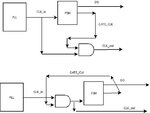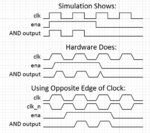axcdd
Full Member level 3
I got 2 example designs and I am wondering how to constraing them correctly.
see attachment

First design:
Signal CLK_in is 120 MHz from PLL. It goes to to FSM module that generates serial data signal DO to external device with 4.3 ns setup and 0 ns hold time referring to clock signal ( CLK_out that has to be gated -- ( gated by signal from FSM register driven by CLK_in signal).
i guess that
is not enought.
Second design is much worse idea -> clock is gated before FSM.
see attachment

First design:
Signal CLK_in is 120 MHz from PLL. It goes to to FSM module that generates serial data signal DO to external device with 4.3 ns setup and 0 ns hold time referring to clock signal ( CLK_out that has to be gated -- ( gated by signal from FSM register driven by CLK_in signal).
i guess that
Code:
derive_pll_clocks -create_base_clocks
derive_clock_uncertainty
create_generated_clock -name CLK_out -source [get_pins {inst6|pll_inst|altera_pll_i|CLK_in}] [get_ports {CLK_out}]
set_output_delay -clock { CLK_out } -max 4.2 [get_ports {DO}]
set_output_delay -clock { CLK_out } -min 0 [get_ports {DO}]is not enought.
Second design is much worse idea -> clock is gated before FSM.
